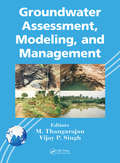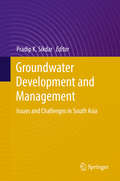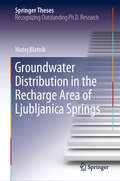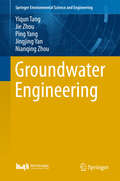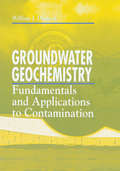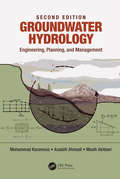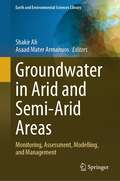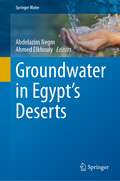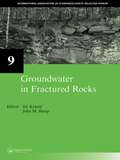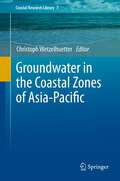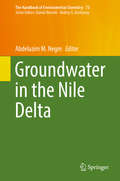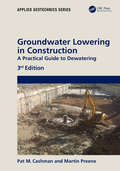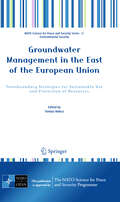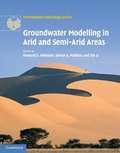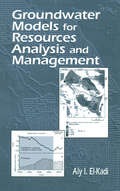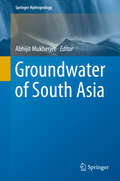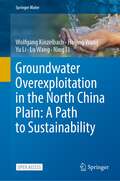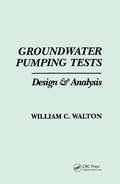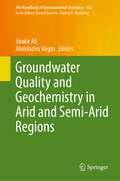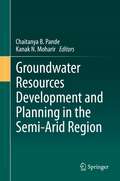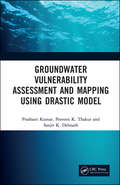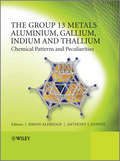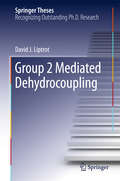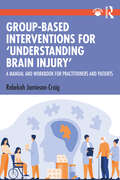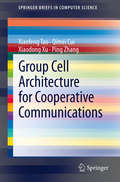- Table View
- List View
Groundwater Assessment, Modeling, and Management
by M. Thangarajan Vijay P. SinghYour Guide to Effective Groundwater Management Groundwater Assessment, Modeling, and Management discusses a variety of groundwater problems and outlines the solutions needed to sustain surface and ground water resources on a global scale. Contributors from around the world lend their expertise and provide an international perspective on groundwater management. They address the management of groundwater resources and pollution, waste water treatment methods, and the impact of climate change on groundwater and water availability (specifically in arid and semi-arid regions such as India and Africa). Incorporating management with science and modeling, the book covers all areas of groundwater resource assessment, modeling, and management, and combines hands-on applications with relevant theory. For Water Resource Managers and Decision Makers The book describes techniques for the assessment of groundwater potential, pollution, prevention, and remedial measures, and includes a new approach for groundwater modeling based on connections (network theory). Approximately 30 case studies and six hypothetical studies are introduced reflecting a range of themes that include: groundwater basics and the derivation of groundwater flow equations, exploration and assessment, aquifer parameterization, augmentation of aquifer, water and environment, water and agriculture, the role of models and their application, and water management policies and issues. The book describes remote sensing (RS) applications, geographical information systems (GIS), and electrical resistivity methods to delineate groundwater potential zones. It also takes a look at: Inverse modeling (pilot-points method) Simulation optimization models Radionuclide migration studies through mass transport modeling Modeling for mapping groundwater potential Modeling for vertical 2-D and 3-D groundwater flow Groundwater Assessment, Modeling, and Management explores the management of water resources and the impact of climate change on groundwater. Expert contributors provide practical information on hydrologic engineering and groundwater resources management for students, researchers, scientists, and other practicing professionals in environmental engineering, hydrogeology, irrigation, geophysics, and environmental science.
Groundwater Development and Management: Issues And Challenges In South Asia
by Pradip K. SikdarThis book deals with the challenges for efficient groundwater management, with a focus on South Asia and India, providing a balanced presentation of theory and field practice using a multidisciplinary approach. Groundwater of South Asia is increasingly confronted with overuse and deteriorating quality and therefore requires urgent attention. Management of the stressed groundwater systems is an extremely complex proposition because of the intricate hydrogeological set-up of the region. Strategies for sustainable management must involve a combination of supply-side and demand-side measures depending on the regional setting and socio-economic situations. As a consequence, the challenges of efficient groundwater management require not only a clear understanding of the aquifer configuration, but also demand for the development of a comprehensive database of the groundwater occurrences and flow systems in each hydrogeological setting. In addition, drilling and well construction methods that are appropriate to different hydrogeological formations need to be implemented as well as real-time monitoring of the status of the groundwater use. Also corrective measures for groundwater that is threatened with depletion and quality deterioration need to be installed. Finally, the legal framework of groundwater needs to be rearticulated according to the common property aspect of groundwater. These challenges should revolve around effective groundwater governance by creating an atmosphere to support and empower community-based systems of decision-making and revisit the existing legal framework and groundwater management institutions by fostering community initiatives.This book is relevant for academics, professionals, administrators, policy makers, and economists concerned with various aspects of groundwater science and management.
Groundwater Distribution in the Recharge Area of Ljubljanica Springs (Springer Theses)
by Matej BlatnikThis book presents a novel approach to studying the groundwater dynamics of and characterising karst aquifers. The content is based on long-term monitoring of groundwater parameters in the epiphreatic caves of a selected karst aquifer: part of the classical recharge area of Ljubljanica River, Slovenia. The recorded data was analysed on the basis of the recharge to the system, which is controlled by outflow from the Planinsko Polje, and on the basis of the known and inferred geometry of the karst conduit system. The book presents numerically tested conceptual models of the observed conduit system, which offer new insights into its structure and function. In closing, the author stresses the importance of caves as groundwater monitoring sites and provides new tools for interpreting cave water level hydrographs. Although the book focuses on a specific site, the methodology introduced here can be applied to numerous other karst systems, lending it considerable practical relevance.
Groundwater Engineering (Springer Environmental Science and Engineering)
by Yiqun Tang Jie Zhou Ping Yang Jingjing Yan Nianqing ZhouIntegrating information from several areas of engineering geology, hydrogeology, geotechnical engineering, this book addresses the general field of groundwater from an engineering perspective. It covers geological engineering as well as hydrogeological and environmental geological problems caused by groundwater engineering. It includes 10 chapters, i.e., basic groundwater theory, parameter calculation in hydrogeology, prevention of geological problem caused by groundwater, construction dewatering, wellpoint dewatering methods, dewatering wells and drilling, groundwater dewatering in foundation-pit engineering, groundwater engineering in bedrock areas, numerical simulation in groundwater engineering, groundwater corrosion on concrete and steel. Based on up-to-date literature, it describes recent developments and presents several case studies with examples and problems. It is an essential reference source for industrial and academic researchers working in the groundwater field and can also serve as lecture-based course material providing fundamental information and practical tools for both senior undergraduate and postgraduate students in fields of geology engineering, hydrogeology, geotechnical engineering or to conduct related research.
Groundwater Geochemistry: Fundamentals and Applications to Contamination
by William J. Deutsch Randy SiegelGroundwater Geochemistry: Fundamentals and Applications to Contamination examines the integral role geochemistry play s in groundwater monitoring and remediation programs, and presents it at a level understandable to a wide audience. Readers of all backgrounds can gain a better understanding of geochemical processes and how they apply to groundwater systems.The text begins with an explanation of fundamental geochemical processes, followed by a description of the methods and tools used to understand and simulate them. The book then explains how geochemistry applies to contaminant mobility, discusses remediation system design, sampling program development, and the modeling of geochemical interactions. This clearly written guide concludes with specific applications of geochemistry to contaminated sites.This is an ideal choice for readers who do not have an extensive technical background in aqueous chemistry, geochemistry, or geochemical modeling. The only prerequisite is a desire to better understand natural processes through groundwater geochemistry.
Groundwater Hydrology: Engineering, Planning, and Management
by Mohammad Karamouz Azadeh Ahmadi Masih AkhbariIncreasing demand for water, higher standards of living, depletion of resources of acceptable quality, and excessive water pollution due to urban, agricultural, and industrial expansions have caused intense environmental, social, economic, and political predicaments. More frequent and severe floods and droughts have changed the resiliency and ability of water infrastructure systems to operate and provide services to the public. These concerns and issues have also changed the way we plan and manage our surface and groundwater resources. Groundwater Hydrology: Engineering, Planning, and Management, Second Edition presents a compilation of the state-of-the-art subjects and techniques in the education and practice of groundwater and describes them in a systematic and integrated fashion useful for undergraduate and graduate students and practitioners. This new edition features updated materials, computer codes, and case studies throughout. Features: Discusses groundwater hydrology, hydraulics, and basic laws of groundwater movement Describes environmental water quality issues related to groundwater, aquifer restoration, and remediation techniques, as well as the impacts of climate change \ Examines the details of groundwater modeling and simulation of conceptual models Applies systems analysis techniques in groundwater planning and management Delineates the modeling and downscaling of climate change impacts on groundwater under the latest IPCC climate scenarios Written for students as well as practicing water resource engineers, the book develops a system view of groundwater fundamentals and model-making techniques through the application of science, engineering, planning, and management principles. It discusses the classical issues in groundwater hydrology and hydraulics followed by coverage of water quality issues. It also introduces basic tools and decision-making techniques for future groundwater development activities, taking into account regional sustainability issues. The combined coverage of engineering and planning tools and techniques, as well as specific challenges for restoration and remediation of polluted aquifers sets this book apart.
Groundwater in Arid and Semi-Arid Areas: Monitoring, Assessment, Modelling, and Management (Earth and Environmental Sciences Library)
by Shakir Ali Asaad Mater ArmanuosThis book provides comprehensive studies from Middle East, African countries and Asia including Afghanistan, Algeria, Egypt, India, Iraq, Kyrgyzstan, Tunisia and Turkey on groundwater management, modelling and monitoring. A broad approach such as modelling, artificial intelligence, machine learning, and statistical models was applied in arid and semi-arid areas for management of the groundwater. These new approaches are currently in high demand. The book delves into the applications of these methods and will be a potential asset to the researchers worldwide. The book is a timely publication containing chapters based on primary data or/and extensive review chapters comprising new emerging techniques. Current high-demand research on management through the application of modelling, artificial intelligence and machine learning is the main selling point of this book.
Groundwater in Egypt’s Deserts (Springer Water)
by Abdelazim Negm Ahmed ElkhoulyThis book brings together contributions from groundwater researchers and scientists on underground water resources in Egypt's deserts. The aquifers' quantity and quality are evaluated in many regions of the Egyptian deserts using established methods that can be effectively employed to investigate the potential for sustainable development in Egypt and similarly arid countries. The water resources in Egypt's deserts are subject to deterioration, mainly by land salinization and water deficiency.This book presents the best management practices, water quantity and quality, and optimal and sustainable usage of available groundwater. The book offers a unique guide for all readers interested in groundwater, modeling, and assessment for sustainable development in Egypt and countries with similar weather and water conditions.
Groundwater in Fractured Rocks: IAH Selected Paper Series, volume 9
by Jiří Krásný John M. Sharp Jr.The hydrogeologic environment of fractured rocks represents vital natural systems, examples of which occur on every continent. This book discusses key issues, methodologies and techniques in the hydrogeology of fractured rocks, summarizing recent progress and anticipating the outcome of future investigations. Forty-four revised and updated papers w
Groundwater in the Coastal Zones of Asia-Pacific
by Christoph WetzelhuetterGroundwater management and conservation becomes a more and more important issue in the heavily urbanized coastal zones of the Asia-Pacific region. This volume presents a comprehensive overview of the status of coastal groundwater research in this diverse region. It includes latest methodologies and technologies to assess processes associated with coastal groundwater development. Case studies and local examples from a broad geographical range of continental shoreline and island settings give an understanding of the diversity of coastal aquifers and the groundwater recourses they harbour. Audience: By providing a clearer understanding of the hydrogeological and hydrochemical processes, this volume offers a critical tool to coastal researchers, geoscientists in related fields, water engineers, groundwater managers and decision makers as it illustrates the human and environmental impacts on coastal groundwater resources and the relationship to coastal zone management strategies and the development of sustainable management approaches.
Groundwater in the Nile Delta (The Handbook of Environmental Chemistry #73)
by Abdelazim M. NegmThis unique volume offers an up-to-date overview of all the main aspects of groundwater in the Nile Delta and its fringes, as well as latest research findings. The themes covered include: · Nile Delta aquifer formation and its characteristics · The use of the groundwater in the Nile Delta and its implications · Sedimentology and hydrogeophysical characteristics · Groundwater investigations and aquifer characterization using current direct resistivity and induced polarization · Groundwater contamination and degradation · Saltwater intrusion and its control · Delineation of groundwater flow and seawater intrusion using various techniques, including one-dimensional subsurface temperature profiles, geoelectrical resistivity, and integrated subsurface thermal regime and hydrogeochemical data · Modeling of groundwater and of saltwater intrusion in the Nile Delta aquifer · Excessive pumping and groundwater quality assessment for irrigation and drinking purposes · Groundwater management for sustainability in the Nile Delta. The volume appeals to postgraduate students, researchers, scientists, professionals, decision makers and planners.
Groundwater Lowering in Construction: A Practical Guide to Dewatering
by Pat M. Cashman Martin PreenePraise for the Second Edition: "This is the book that the dewatering sector really needs – it is reliably based on sound theory and profound understanding of the physical processes, yet is presented in a very accessible and user-friendly manner. It draws on many, many decades of experience, and yet is utterly up to date. . . . It is a one-stop shop for the dewatering practitioner – who can nonetheless rest assured that the theoretical basis of the methods presented is flawless."— Professor Paul L. Younger, FGS, FICE, C.Geol., C.Eng., FREng, University of Glasgow, Scotland, UK "The best reference on this topic available . . . and will prove useful to a wide variety of readers ranging from junior construction engineers or dewatering contractors to theoretical hydrogeologists and environmental managers. It is rare that a book is able to bridge the gap between theoretical design guidance and practical application." — S.N. Sterling, University of Waterloo, Canada The extensively updated Groundwater Lowering in Construction: A Practical Guide to Dewatering, 3rd Edition offers practical advice on all phases of groundwater control systems, from planning and design, through installation and maintenance, and ultimately decommissioning. The expertise provided in this book can help you improve working conditions, increase project viability, save time and reduce excavation costs. Designers and managers of construction and engineering projects are given the tools necessary to effectively control groundwater. The content is divided into three sections – Principles, Design and Construction. The Principles section explains the fundamentals of groundwater flow as it relates to civil engineering excavations. The Design section explores in extensive detail site investigation, permeability assessment methods and groundwater control strategies. Chapters in the Construction section describe dewatering and exclusion techniques, and examine the complete life cycle of a groundwater control scheme, including monitoring, maintenance and decommissioning. This section incorporates eleven case histories from the authors’ casebook. The 3rd edition has been greatly revised and updated, and contains more than 200 new illustrations. The new content covers: Permeability of soils and rocks Groundwater problems for excavations in rock Groundwater control for tunnelling projects, such as shafts and cross passages Methods for assessing permeability Decommissioning of dewatering systems Optimisation of groundwater control schemes. The new, expanded content offers valuable direction that can give you a true competitive advantage in the planning and execution of temporary and permanent dewatering works for excavation and tunnelling. Written for practising engineers, geologists and construction managers, as well as postgraduate engineering students, this revamped manual on design and practice presents numerous case studies and extensive references to enhance understanding. Martin Preene is a groundwater consultant, based in the UK. He has more than 30 years’ experience working on dewatering and groundwater control projects worldwide.The late Pat Cashman was the leading British exponent of groundwater control for his generation, championing a practical and straightforward approach for more than forty years.
Groundwater Management in the East of the European Union
by Tomasz NaleczThis volume is the result of work carried out under the NATO SPS Study Pilot Project "Sustainable Use and Protection of Groundwater Resources - Transboundary Water Management." It contains basic information on hydrogeological conditions, groundwater management and monitoring in areas of the Belarus, Lithuanian, Polish and Ukrainian borders, simultaneously borders of the European Union with its eastern partners. In view of the importance of the rational utilization of groundwater reserves, which is essential for our future existence, the book presents recommendations for a united methodology of an integrated groundwater monitoring system in this transnational area. The contributions also cover environmental and surface water issues that have direct effects on groundwater resources. The financial dimension of resource mobilization for environmental projects in Eastern Europe also features as part of a complex project solution.
Groundwater Modelling in Arid and Semi-Arid Areas
by Howard S. Wheater Simon A. Mathias Xin LiArid and semi-arid regions face major challenges in the management of scarce freshwater resources under pressures of population, economic development, climate change, pollution and over-abstraction. Groundwater is commonly the most important water resource in these areas. Groundwater models are widely used globally to understand groundwater systems and to guide decisions on management. However, the hydrology of arid and semi-arid areas is very different from that of humid regions, and there is little guidance on the special challenges of groundwater modelling for these areas. This book brings together the experience of internationally-leading experts to fill a gap in the scientific and technical literature. It introduces state-of-the-art methods for modelling groundwater resources, illustrated with a wide-ranging set of illustrative examples from around the world. The book is valuable for researchers, practitioners in developed and developing countries, and graduate students in hydrology, hydrogeology, water resources management, environmental engineering and geography.
Groundwater Models for Resources Analysis and Management
by Aly I. El-KadiWritten by renowned experts in the field, this book assesses the status of groundwater models and defines models and modeling needs in the 21st century. It reviews the state of the art in model development and application in regional groundwater management, unsaturated flow/multiphase flow and transport, island modeling, biological and virus transport, and fracture flow. Both deterministic and stochastic aspects of unsaturated flow and transport are covered. The book also introduces a unique assessment of models as analysis and management tools for groundwater resources. Topics covered include model vs. data uncertainty, accuracy of the dispersion/convection equation, protocols for model testing and validation, post-audit studies, and applying models to karst aquifers.
Groundwater of South Asia (Springer Hydrogeology Ser.)
by Abhijit MukherjeeThis book presents recent findings from the South Asian region (SA), broadly including groundwater studies on (a) quantity, (b) exploration, (c) quality and pollution, (d) economics, management and policies, (e) groundwater and society, and (f) sustainable sources. It offers a compilation of compelling, authentic insights into groundwater scenarios throughout the water-stressed South Asia region. Comprising Afghanistan, Bangladesh, Bhutan, India, Myanmar, Nepal, Pakistan, and Sri Lanka, it is the most densely populated region in the world: It occupies approximately 4% of the global land area but supports more than 25% of the global population. The SA region now faces an acute shortage of fresh water due to a rapid rise in water demand and changes in societal water-use patterns. Combining essential advances and perspectives, this book offers a valuable resource for all scientists, planners and policymakers who are interested in understanding and developing the SA and other related areas.
Groundwater overexploitation in the North China Plain: A path to sustainability (Springer Water)
by Wolfgang Kinzelbach Haijing Wang Yu Li Lu Wang Ning LiOver-pumping of aquifers is a worldwide problem, mainly caused by agricultural water use. Among its consequences are the falling dry of streams and wetlands, soil subsidence, die-off of phreatophytic vegetation, saline water intrusion, increased pumping cost and loss of storage needed for drought relief. Stopping or reversing the trend requires management interventions. The North China Plain serves as an example. A management system is set up for a typical county. It contains three components: monitoring, decision support based on modelling, and implementation in the field. Besides all monitoring data, the decision support module contains an irrigation calculator, a box model, and a distributed groundwater model to project the outcomes of different water allocation scenarios. In view of grain security, a solution combines an adaptation of the cropping system with imports of surface water from the South. The Open Access book does not only describe the problem and the path to its solution. It also gives access to nine manuals concerning methods used. They include computer programs and the game Save the Water. The Chinese experience should be of considerable interest to other regions in the world which suffer from over-pumping of aquifers.
Groundwater Pumping Tests
by William C. WaltonThis practical book 'Groundwarer Pumping Tests', details concepts, techniques, field work, case studies, and microcomputer models-information designed to improve accuracy and reliability. The reader is expected to have a working knowledge of hydrogeology or access to books on groundwater geology and hydrology. Too frequently, groundwater pumping test design and analysis ignore well storage capacity, delayed gravity yield, well partial penetration, and aquitard storativity impacts without proving them negligible. As a result, erroneous conclusions are reached concerning aquifer system hydraulic characteristics, boundaries, and discontinuities. Pumping test data often is filtered arbitrarily without adequate justification in attempts to match inappropriate aquifer models and field conditions. Antecedent water level trends and water level adjustments for changes in barometric pressure and surface water stages frequently are ignored in calculating drawdown and recovery. Finally, manual graphic analysis supplemented with microcomputer programs is, to an excessive extent, being replaced by fully automatic microcomputer analysis without critical examination of interpretative methods in program algorithms and their limitations. This book will focus needed attention on the facets mentioned above.
Groundwater Quality and Geochemistry in Arid and Semi-Arid Regions (The Handbook of Environmental Chemistry #126)
by Shakir Ali Abdelazim NegmThis book reviews groundwater quality and its major global contaminants, and collects the latest advances in the analysis, remediation, risk assessment, and hydrogeochemistry of groundwater in countries such as Algeria, Egypt, Ghana, Kazakhstan, Morocco, Saudi Arabia, and the USA. This book mainly focuses on the major arid and semi-arid areas where groundwater is scarce and highly polluted with geogenic and anthropogenic contaminants and the recharge to the groundwater is negligible due to limited rainfall. Divided into 2 parts, the book starts by covering topics like assessment and protection of groundwater in arid and semi-arid regions, groundwater pollution, and contamination risk assessment. Particular attention is given to the application of environmental isotopes in groundwater studies and how anthropogenic activities impact groundwater quality, the impact of irrigation reservoirs in groundwater and soil quality, and how artificial intelligence is applied to forecast groundwater quality. In the second part of this book, readers will find more about the major global contaminants of groundwater in arid and semi-arid areas, including a geochemical analysis of fluoride and nitrate contamination. Supported by regional case studies, this book appeals to researchers, scholars, and professionals working in the field of groundwater contamination and remediation and is also an important account for policymakers.
Groundwater Resources Development and Planning in the Semi-Arid Region
by Chaitanya B. Pande Kanak N. MoharirThis book addresses the various challenges in achieving sustainable groundwater development, management, and planning in semi-arid regions, with a focus on India, and discusses advanced remote sensing and GIS techniques for the estimation and management of groundwater resources. The book is timely as there is a need for a better understanding of the various tools and methods required to efficiently and sustainably meet the growing demand for clean surface and groundwater in developing countries, and how these tools can be combined with other strategies in a multi-disciplinary fashion to achieve this goal in water-scarce regions. To wit, the book combines remote sensing and GIS techniques, runoff modeling, aquifer mapping, land use and land cover analyses, evapotranspiration estimation, crop coefficients, and water policy approaches. This will be of use to academics, policymakers, social scientists, and professionals involved in the various aspects of sustainable groundwater development, planning, and management.
Groundwater Vulnerability Assessment and Mapping using DRASTIC Model
by Prashant Kumar Praveen Thakur Sanjit DebnathThis book shows the effectiveness of DRASTIC model in a geographical setting for validation of vulnerable zones and presents the optimization of parameters for the development of precise maps highlighting several zones with varied contamination. Impact of vadose zone has also been assessed by considering every sub-surface layer. Exclusive title covering effectiveness of DRASTIC model for groundwater vulnerability assessment Reviews of the strengths and limitations of assessment methods Presents multi-criteria evaluation of hydro-geological and anthropogenic factors Discusses integration with geographic information system (GIS) and remote sensing (RS) Includes application of groundwater governance framework with a case study study of a geographical setting
The Group 13 Metals Aluminium, Gallium, Indium and Thallium
by Simon Aldridge Anthony J. DownsThe last two decades have seen a renaissance in interest in the chemistry of the main group elements. In particular research on the metals of group 13 (aluminium, gallium, indium and thallium) has led to the synthesis and isolation of some very novel and unusual molecules, with implications for organometallic synthesis, new materials development, and with biological, medical and, environmental relevance.The Group 13 Metals Aluminium, Gallium, Indium and Thallium aims to cover new facts, developments and applications in the context of more general patterns of physical and chemical behaviour. Particular attention is paid to the main growth areas, including the chemistry of lower formal oxidation states, cluster chemistry, the investigation of solid oxides and hydroxides, advances in the formation of III-V and related compounds, the biological significance of Group 13 metal complexes, and the growing importance of the metals and their compounds in the mediation of organic reactions. Chapters cover:general features of the group 13 elementsgroup 13 metals in the +3 oxidation state: simple inorganic compoundsformal oxidation state +3: organometallic chemistryformal oxidation state +2: metal-metal bonded vs. mononuclear derivativesgroup 13 metals in the +1 oxidation statemixed or intermediate valence group 13 metal compoundsaluminium and gallium clusters: metalloid clusters and their relation to the bulk phases, to naked clusters, and to nanoscaled materialssimple and mixed metal oxides and hydroxides: solids with extended structures of different dimensionalities and porositiescoordination and solution chemistry of the metals: biological, medical and, environmental relevanceIII-V and related semiconductor materialsgroup 13 metal-mediated organic reactionsThe Group 13 Metals Aluminium, Gallium, Indium and Thallium provides a detailed, wide-ranging, and up-to-date review of the chemistry of this important group of metals. It will find a place on the bookshelves of practitioners, researchers and students working in inorganic, organometallic, and materials chemistry.
Group 2 Mediated Dehydrocoupling
by David J. LiptrotThis book presents an in-depth study into the utility of σ-bond metathesis in Group 2 mediated reactivity. A comprehensive introduction defines the state of the art in both Group 2 mediated catalysis and dehydrocoupling. Structural investigations giving rise to a range of mixed s-block metal hydrides including a remarkable dodecabimetallic decahydride are then described. Subsequent extensive mechanistic work focussing on both silicon-nitrogen and boron-nitrogen dehydrocoupling gives insights into both congeneric effects down Group 2 and ligand effects centring upon magnesium. These studies show the striking effects of these factors, as well as the electronic nature of the hydridic coupling partner. Finally, the unprecedented introduction of single-electron transfer steps into Group 2 catalytic manifolds is described. The use of the stable radical TEMPO to induce single-electron transfer to substituents bound to Group 2 centres coupled with σ-bond metathesis allows a novel hydrogen release from silanes.
Group-Based Interventions for 'Understanding Brain Injury': A Manual and Workbook for Practitioners and Patients
by Rebekah Jamieson-CraigThis hands-on volume is both manual and workbook, designed to be used alongside the Understanding Brain Injury Group. This group aims to increase the understanding and acknowledgement of acquired brain injury and find ways of coping with the consequences. The manual section outlines the steps needed for practitioners to run the Understanding Brain Injury Group successfully, and the workbook section – also available as a downloadable resource – is intended to be used by patients. The chapters in the manual mirror the structure of the eight sessions of the group, highlighting differing aspects of having a brain injury. Initially, the sessions cover psychoeducation regarding brain injury and what neurorehabilitation entails. Following this, the group then focuses on living with the consequences of brain injury, whether that represents physical, cognitive, emotional or lifestyle changes. Participants are invited to share their experiences and discuss coping strategies to help with both the new limitations as well as the unwanted emotions that frequently exist after brain injury. Goals are set at the beginning of the group and are revisited at the end to decide on whether they were being realistic, overachieving or pessimistic in their outlook at the start of the group. Throughout, the members of the group can record their session activity in the accompanying workbook. Created to be used by clinicians, therapists or any individual, this resource can be used in a post-acute setting such as a neurorehabilitation unit, a slow-stream rehab setting such as community neurorehabilitation or homes specifically aimed at catering for the needs of those with neurological impairments.
Group Cell Architecture for Cooperative Communications
by Qimei Cui Ping Zhang Xiaodong Xu Xiaofeng TaoDriven by the increasing demand for capacity and Quality of Service in wireless cellular networks and motivated by the distributed antenna system, the authors proposed a cooperative communication architecture--Group Cell architecture, which was initially brought forward in 2001. Years later, Coordinated Multiple-Point Transmission and Reception (CoMP) for LTE-Advanced was put forward in April 2008, as a tool to improve the coverage of cells having high data rates, the cell-edge throughput and/or to increase system throughput. This book mainly focuses on the Group Cell architecture with multi-cell generalized coordination, Contrast Analysis between Group Cell architecture and CoMP, Capacity Analysis, Slide Handover Strategy, Power Allocation schemes of Group Cell architecture to mitigate the inter-cell interference and maximize system capacity and the trial network implementation and performance evaluations of Group Cell architecture.
